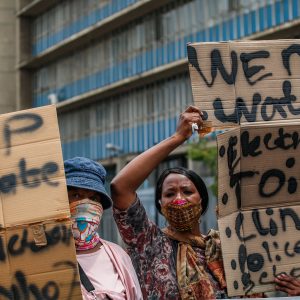New Books | Land Matters
As the Marikana miners protested for better wages, their wives in the Eastern Cape were able to send money earned from small-scale farming efforts on communal land.
Author:
5 July 2021

This is a lightly edited excerpt from Land Matters: South Africa’s Failed Land Reforms and the Road Ahead (Penguin Random House, 2021) by Tembeka Ngcukaitobi.
Women of Marikana
In August 2012 a miners’ strike in the town of Marikana, in North West province, gripped the nation. At the centre of this unrest was Lonmin, a mining company that owned two platinum mines, one in Karee and the other in Marikana. The two sites were separated by a hill. In 2011 Lonmin had sacked about 9 000 workers for participating in an illegal strike. Some were later re-employed, but many remained jobless. When the 2012 strike over wages began, the grievances of the previous year still lingered on. The company’s defence was that it had struck a three-year wage deal with the majority union at the time, the National Union of Mineworkers (NUM). Now, however, the status of the majority union was being challenged by an emerging player, the Association of Mineworkers and Construction Union (Amcu). Workers were demanding the cancellation of the NUM wage deal, which the company refused. A court ruled the strike illegal.
Days went by. Weeks. Months. The mine was closed and all workers were told to “return home”. For some, this meant travelling more than a 1 000km to the Eastern Cape, from which Lonmin drew some 30% of its workforce. Some left. Many did not. The strike went on. Each morning workers left their ramshackle settlements in Nkanini (“place of strife”) to congregate at the hill adjacent to the mine. There, they would denounce their standard of living, their low wages, their abandonment by the government, and the nonchalant attitude of the mining bosses who reaped large bonuses despite failing to return profits to the mines’ shareholders. But there was a problem. The company strictly enforced a “no work, no pay” rule, throwing many miners who already earned a low wage into a state of destitution. On the other hand, miners had to “enforce” the strike, resulting in threats, intimidation and violence against any employee who refused to join them. The police were mobilised by the company through its political connections to break the strike. There was resistance.
On 16 August 2012, the police opened fire, spraying hundreds of rounds of ammunition against the striking workers, killing 34 of them and seriously injuring 78. At the commission of inquiry that was called by the government, the police would deny, prevaricate and evade the truth. Several excuses were conjured up for the violence, but there was no refuting the cold, hard facts: the police were responsible for the brutal murder and serious injury of workers who participated in the wage strike.
Related article:
Despite the violent deaths of their comrades on 16 August, the strikers soldiered on with even more intensity. It was only at the end of September 2012 that a resolution was found. For a month and a half, the miners had been without wages. How did they survive? In 2015, journalist Niren Tolsi wrote a remarkable story about the surviving wives of the Marikana miners. He was able to document the personal stories and devastating consequences of the tragedy through the miners’ families in Lesotho, Swaziland and the Eastern Cape. Remittances to the mineworkers’ families, ranging from R1 000 to R3 000, had dried up. New strategies of survival had to be found by the widows. Women like them were described by Phyllis Ntantala in 1958 as widows of the reserves “whose husbands are torn away from them to go and work in the cities, mines and farms – husbands who because of the migratory labour system cannot take their wives with them and, because of the starvation wages they receive, are forced to remain in the work centres for long periods – strangers in a strange land – but equally strangers at home to their wives and children”.
As Ntantala pointed out, the separation from their husbands did not mean the end of their lives. They “remain alone in the reserves to build the homes, till the land, rear the stock, bring up the children’. Talking about the women of Marikana as widows in the former reserves – the labour-sending areas – should not blind us to the significance of most women in Marikana who, as Asanda Benya has shown, became “mistresses to mineworkers” and undertook to “look after the migrant workers day in and day out, as opposed to their legally recognised wives, who remain behind”. During the strike, this role was elevated as women gave support in material ways: they provided hiding places from police searches, shared their own money and took food to the hill where the men were striking.
Related article:
We can now provide another partial answer to how some of the men of Marikana survived the many months of the strike with no income. In Centane and Mbashe in the Eastern Cape, where some of the Marikana miners hailed from, a farming project driven by the women-owned multi-investment company Wiphold was launched in 2012. The Centane and Mbashe Agricultural Initiative uses communal land for agricultural development. The model focuses on high social impact, income generation and food security, primarily for women living in the villages of the former Transkei, an area known for poverty since the end of apartheid. Its goals are to encourage the development of viable small-scale commercial agriculture on communal land and to challenge financial and other agri-finance institutions to make capital more easily accessible to small-scale and emerging farmers. By 2017, the initiative had witnessed some success. In the private sector, the insurance giant Old Mutual and one of South Africa’s largest banks, Nedbank, had invested in the project.
For its part, the project made a profit by 2016. But the success of an initiative like this cannot be measured by profitability alone. Social impact also counts. By 2017 there were 34 villages participating in the initiative, with a total of 2 023 landholders and project members. Of that number, 1 476 (73%) were landholders and 547 were project members. The income generated from maize production can be used to feed families, reducing their dependency on remittances from Johannesburg. One of their remarkable achievements, announced by Wiphold executive Gloria Serobe, was that the women in the project were able to support their men during the Marikana strike.
They were sending money to their husbands in Johannesburg from the income generated by their farming activities. While the land was communal, they did not require a title to put the land to productive use. Undisturbed control over the land, with secure rights, and access to capital and some technical assistance were the key ingredients to making a success of the project. By supporting their men in Johannesburg with money from villages in the former Transkei, these women upended the common pattern of money flow from mining areas to the labour-sending regions. Now, in their greatest hour of need, the men of Marikana were supported by their women.
Related article:
The past and present are not short of stories of women’s success as farmers, landowners, communal land workers, claimants and beneficiaries. But the general conception of women participating in the land debate tends to restrict them to beneficiary positions. But it is by including women in the entire food production value chain that we can “improve the quality of life of all citizens and free the potential of each person”, as the Constitution’s preamble provides. Today, however, statistics from the Commission on Restitution of Land Rights show that less than 25% of the beneficiaries of the land restitution programme were women or women-headed households.
The same applies to the beneficiary figures for land redistribution, which are equally appalling. It is then not a surprise that women owners of agricultural land make up no more than 12%, and Black women a paltry 2%. The exclusion cannot be blamed on the past any more. Nor can it be blamed on lack of talent. The problems stem from the patriarchal structures in the land and agricultural sectors, which replicate male power and entrench the marginalisation of women. If progress is to be made in reversing this, the structures should be dismantled first. But how should we do this?



